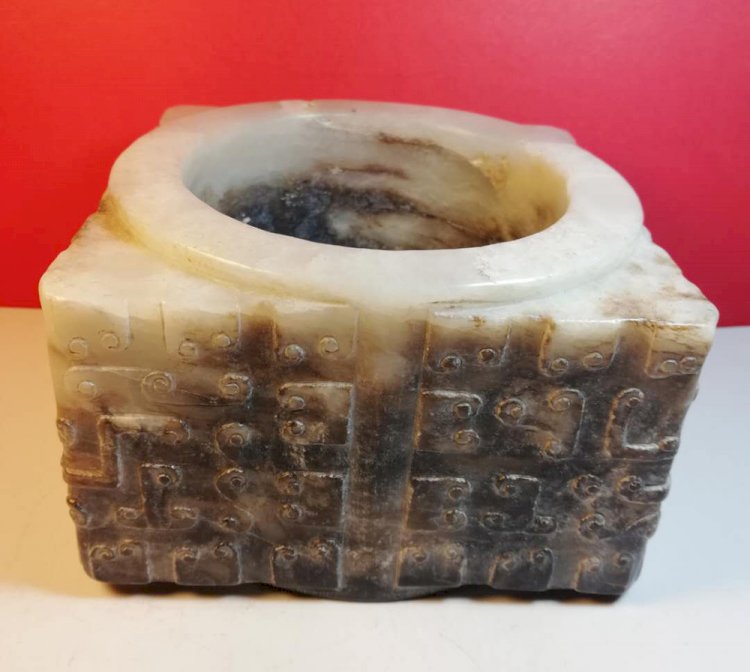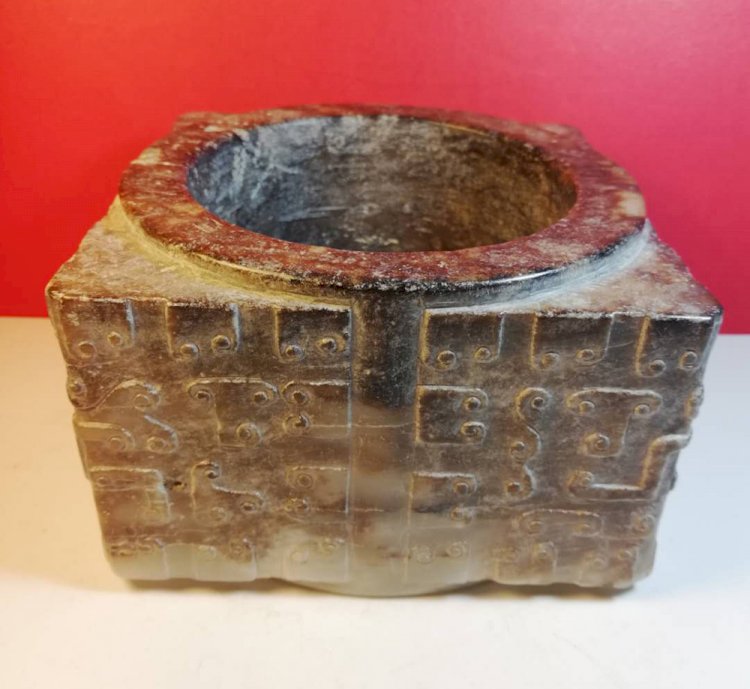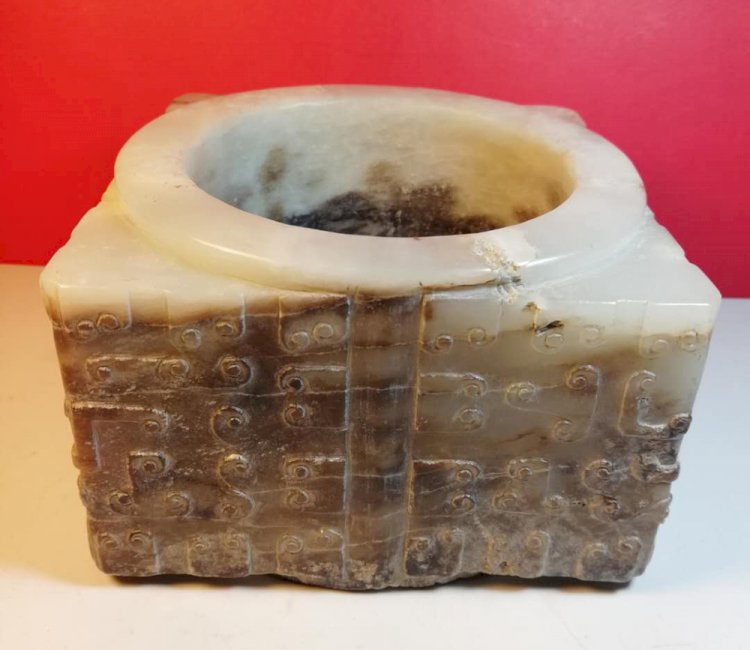D21 White Jade Zang Cong - Queen’s Ritual Jade in Zhou Dynasty
White Jade Zang Cong - Queen’s Ritual Jade in Zhou Dynasty
D21 White Jade Zang Cong - Queen’s Ritual Jade in Zhou Dynasty (Height: 8cm;About 12.38cm on each side )
Most of the jade CONGs are square columns, the middle is cylindrical, the upper and lower parts of the cylinder are protruding beyond the square columns. The jade Cong unearthed in the Neolithic age is generally high, but there are also very small jade Cong. Most of the jade CONGs are carved with animal face patterns, forming a god cabinet symbolizing the god of ancestors. Maybe the ancients wanted to make their ancestors and gods attach to them for sacrifice, or they might put the jade Cong on a round wooden stick as a guard of honor.
In the Shang and Zhou dynasties, the number of Cong became fewer and fewer, the height of jade Cong was generally lower, and there were many light and plain Cong, which didn't seem to inherit the Liangzhu culture, which was dominated by animal face pattern, and gradually interpreted the jade Cong as: the inner circle is like the sky, and the outer part is like the ground. After that, it was taken as a mark of the ground.
According to the book of Etiquette of Zhou Dynasty (Warring States period)”, Cong is the auspicious jade owned by the empress and the wives of the feudal lords, is also a ritual instrument for worshiping the ground. The king and the Duke, the Marquis, the count, the viscount and the Baron are all men. Their ritual jades are GUI and Bi. Their empress and the ladies are all women. Their ritual jade is Cong. In addition, in ancient times, Bi was used in rites, and heaven belonged to Yang; Cong was used in rites, and earth belonged to Yin. It can be seen that all male, positive, with GUI, with Bi; female or negative with Cong.
For example, "six ritual jades" mean the nobility's reverence and inferiority. It is GUI and Bi of different scales stipulated by the court, which are given to ministers as symbols of their power. That is to say, six GUIs and Bi of different specifications are held in their hands when presenting to the emperor . Different jade carvings show different identities, just like the honor guard of European representative power.
In the book of Etiquette of Zhou Dynasty, Chun Da Zongbo, Official of Spring said: ‘Jade as "six rituals" ( six kinds of auspicious ritualistic wares) to match the level of the states: the king holds the “Zhen Gui ” (jade tablet of overpower) , the Duke holds the “Huan Gui” (jade tablet of pillar) , the Marquis holds the “Xin Gui” (jade tablet of credit), the Earl holds the “Gong Gui” (jade tablet of humble), the Viscount holds the “Gu Bi” (jade disc of grain), the Baron holds the “Pu Bi” (jade disc of sedge). This "Six Ritual Jades" are also referred to as "ceremonial wares" in the court. The so-called "Rui" is the use of jade as an artifact in ancient times for the purpose of granting officials and titles. This "Six Rui" is also referred to as "ceremonial ware" in the court.The ritual vessels in the jade are mainly the "six ritual jades" used by the court to hire officials, and the "Six Vessels" used to worship the heaven and earth.
"Six Vessels": It is a ceremonial utensil made of six different colors of jade, such as: sky green ,yellow, green, red, white.
They were used by the emperor to worship the heaven, earth, and the four sides. "Six Vessels" also have carved patterns. In the book of “Etiquette of Zhou Dynasty, Chun Da Zongbo, Official of Spring” said: : "Jade is used as the six instruments, heaven and earth are worshipped, "Jade as jade wares, to honor the heavens and the earth: to honor the heavens with the jade tublet of the clour of sky green; to honor the land with the jade tublet in yellow; to honour the East with the jade tablet in green; to honour the South with the red jade “Zhang”; and respect the West with jade tiger in white ; to honour the North with Jade “Huang” (dark jade pendant)”. That's to say, "cong" is used to honour the earth.
The article “ Exquisite craftsmanship, Etiquette of Zhou Dynasty," states that the emperor had a "Zhengui" to make his ritual vessels, and the queen (the queen of the emperor) also had her ritual vessels, which was "Big Cong", also known as "Neizhen". And the feudal lords and their wives also have their ritual vessels. Regardless of their husbands' titles, they each have an eight inch Cong. As the jade people said in Zhou Dynasty, "Cong is eight inches long, and the feudal lords give them to their wives.". "That is to say, the court made an eight inch jade Cong and sent it to thefeudal lords and transferred it to their wife.".
In addition: some carved jade Cong are called “Zang Cong." The article “Jade Man, Etiquette of Zhou Dynasty, said: "the empress uses it as a symbol of power”; the emperor uses it as a symbol of power. " Power means to symbolize their power. Other patterns of jade Cong, except for some plain Cong, have no patterns. In the Neolithic period of Liangzhu culture, there are many patterns of animal faces or extremely rare God emblem. In the Eastern Zhou and Han Dynasties, jade Cong became rare, but the patterns were complicated.
This large-scale white jade clan is the Ritual Jade of the empress of Zhou Dynasty, which is said by the article “Jade Man, Etiquette of Zhou Dynasty :"... a symbol of queen power. It is a harmonious white jade, which is jade, shiny and dense, with refined light content. Some of it has a light ink color, and it has an ancient flavor. The carving craftsmanship is simple, elegant, even, the decoration is solemn, and the carving pattern is symmetrical and harmonious. The ceremonial wares of the Zhou Dynasty must be in a regular shape, symmetrical and balanced. This white jade urn as a ritual implement reflects this form. It takes the form of "Cong" in the "six vessels" as "empress’s ritual jade" , as a symbol of power. It shows the theological thought of "heaven and earth are should be honored together" in the Shang and Zhou dynasties, as well as the nature, human relations and religious politicization. It contains the classical art and cultural spirit of the royal family of the Zhou Dynasty, and is a rare cultural heritage of human history!
Its appearance reflects the time background, religious beliefs, historical culture, and sculpture art of this period of the Zhou Dynasty, all of which have great significance and value, and money is by no means an argument. For all of the above, they have provided extremely valuable and researchable material information, which is unparalleled in the world and sincerely honors the Chinese nation! This is really the "priceless treasure" of the royal family of the Zhou Dynasty!






























